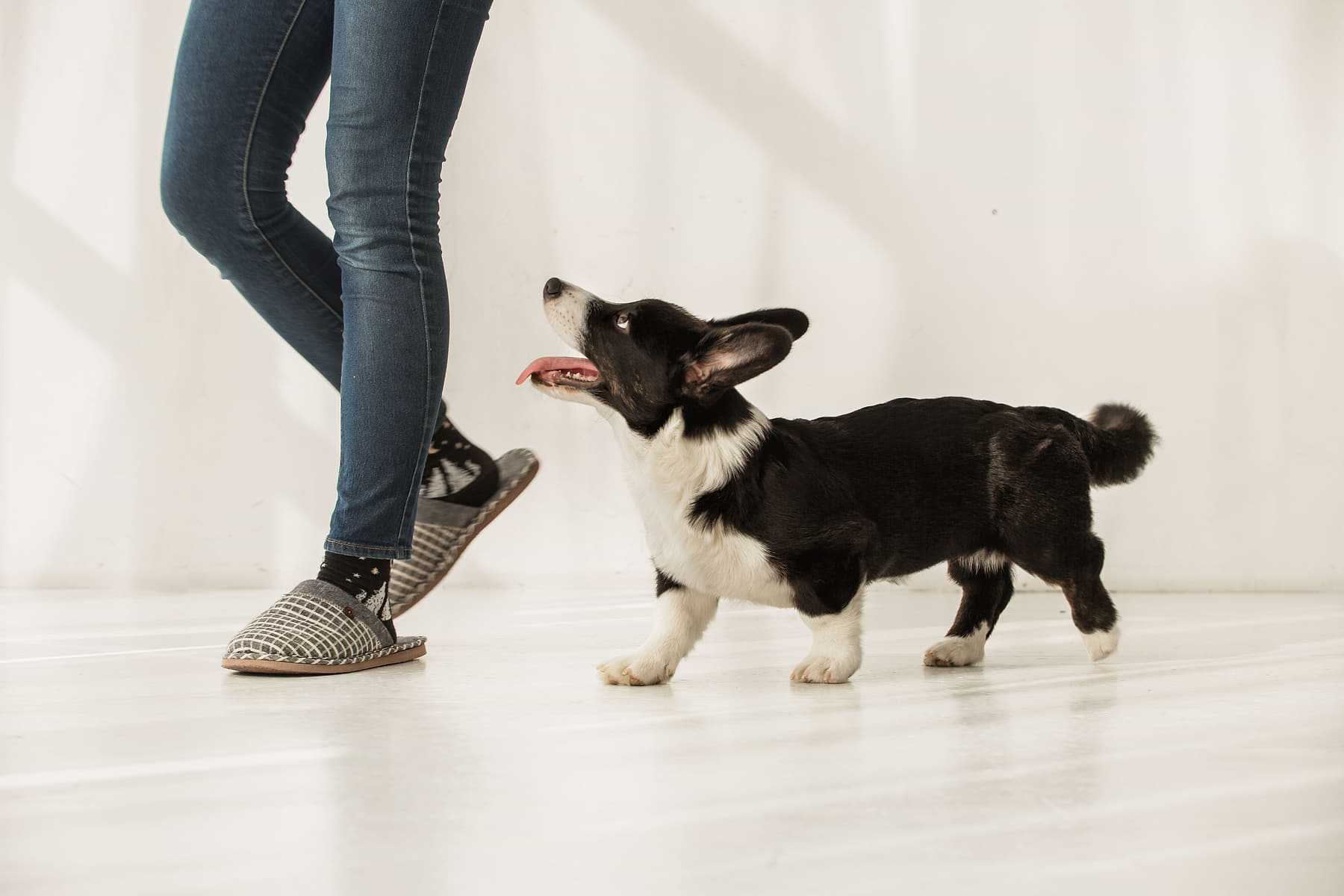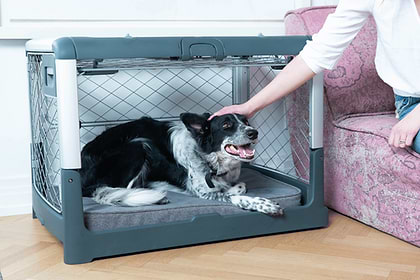As a pet parent, there are few feelings better than being completely trusted by your dog. Getting a cuddle at the end of a hard day can remind us why having a canine companion is so worth it.
Unfortunately, there does come a point when affection crosses a line into an unhealthy level of clinginess. If this is the case for your pet, it is in everyone’s best interest to sort out the issue.
It is also worth noting that different pet parents are likely to have their own definition of “clinginess.” What is a reasonable and even endearing show of loyalty to one person might seem overly dependent to the next. No one definition is more correct than the other, as long as you are caring for your dog.
When you get a pet, you should be prepared to give them all of the attention, love, and care that they need. That being said, being attached at the hip all day, every day is not helping anyone.
What’s Making My Dog Clingy?
A dog’s refusal to leave your side can come from a range of sources. Whether you adopted an adult rescue dog from a shelter or if you have had your dog since puppyhood, any pet can be clingy. The first step in identifying the cause behind your pet’s clingy behavior is to determine whether this is new, or if your pet has always been this way.
If this is the way that your dog has always been, then they could just be more insecure or stressed out by nature. Otherwise, if your dog has grown accustomed to always being with you then it might feel odd to them to do anything else. Your dog might be your best friend, but that does not necessarily mean they should follow you into the bathroom.
On the other hand, it is also possible that this behavior has only just started. If that is the case with your pet, it is worth exploring any changes in your pet’s daily routine that could have inspired your dog’s clinginess. We will discuss a few of these potential changes, as well as what you can do to help them feel more secure.
If you are okay with (or even enjoy) your dog’s constant companionship, it is still a good idea to consider the source. This should not turn into an unhealthy dependency, and your dog should become comfortable with the idea of being alone for periods of time.
Do Dogs Get Clingy When They’re Bored?
The first reason that dogs get overly clingy is a very common one — it is entirely possible that your dog is just plain old bored. Think about it, if you were a pet who only had you and possibly another family member for company, wouldn’t you hang around them too? When you add in that your pet might not have much else to do, that clinginess can increase tenfold.
Sometimes, pet parents can underestimate just how much mental stimulation their dogs need. Since we unfortunately are not able to have full conversations with our dogs, this is understandable. That is why it is so important that we pay close attention to the signs that our dogs try to communicate with us.
By having a thorough understanding of your dog’s body language, as well as how they tend to act when they are happy and healthy, you can quickly recognize that something is amiss. Once you do notice that something is off with your dog, it is crucial to take the steps necessary to correct it.
A pet parent has nearly total control over their dog’s life. That is not a responsibility to be taken lightly, so it is one that should be considered often. If your dog starts to engage in destructive behaviors like digging and chewing, and is regularly whining and barking for no reason, it is entirely possible that they are bored.
Later in this article, we will address how you can help your dog feel more mentally stimulated and independent.
Are Dogs More Affectionate When They’re in Heat?
Unlike many of the other reasons that a dog might be clingy on our list, this one is primarily due to physical reasons. Unspayed female dogs will go through heat twice per year, and a lot of symptoms can come along with it. You might notice that your dog is urinating more frequently and they might pay more attention to male dogs. Changes in behavior are also exceedingly common.
There are four stages to a dog’s heat. The first one tends to be where the majority of the behavioral shifts occur. During this stage, some dogs will become more standoffish or even cranky. However, it is also possible for dogs to become much more clingy than they usually are.
If you suspect that your clingy dog might be exhibiting these behaviors because they are starting their heat, keep an eye out for other signs. In the coming weeks, your dog’s appetite is also likely to go through change. Whether they are eating much more or much less dog food, either shift is something worth noticing.
Why Do Dogs Get Separation Anxiety?
Separation anxiety can be quite common in dogs of any background or age. This is because dogs are pack animals, and as such feel much more comfortable around other beings that they trust. If they are a puppy, this might take the form of constantly being around their littermates. In the case of older dogs, this could be other pets in the household or their pet parents.
This fear and insecurity can strike dogs even if they are alone for just a short period of time. Separation anxiety panics often result in messes around the house, torn-up furniture, and more. If your neighbors let you know that your dog can be heard barking and whining when you are not home, that is another classic sign of separation anxiety in dogs.
These feelings are common in puppies or dogs who have just been adopted, but they can also occur in senior dogs who have been with you for all or part of their lives. Health issues such as vision loss and other kinds of decline can all contribute to their desire to always be near you.
Do Changes in My Life Affect My Dog?
When there are significant changes in our lives, we might not consider how they also affect those around us. From our family to our friends, everyone is likely to feel the change. At these times, we have to remember that our pets might just be the most affected of all.
Our dogs do not understand why they are moving houses, or why their routine is now different. All that our dogs know is that things are different now, and that can be really scary.
Why Are Some Dogs More Affectionate Than Others?
The truth is that there is no one reason why some dogs are more affectionate than others. Some pets are simply born that way, while others learn the behaviors as they grow.
Your dog might go through different stages and amounts of clinginess throughout their life, and that is perfectly normal. If at any point you suspect that something is wrong, however, it is time to speak with your vet.
Helping Your Dog Deal With Separation Anxiety and Clinginess
Give Your Dog Exercise
Even if you are already taking your dog on regular walks, it is possible that they need more exercise. Each pet is bound to have their own exercise requirements. For instance, a Chihuahua is going to have vastly different needs than large dog breeds like German shepherds or Labrador retrievers. Consider your pooch’s individual needs, and make sure that they are being met.
Cure Your Dog’s Boredom With Mental Stimulation
A bored dog is a destructive dog, or at the very least a disruptive dog. In order to avoid this kind of unsavory dog behavior, offer your dog different kinds of mental stimulation whenever possible. Mental stimulation can come in many forms, but toys are one of the easiest and most fun ways to help your dog feel content.
Does your dog have enough toys now? If so, are they readily available for any moment when your pet feels ready to play? Even if your dog has more toys than they could possibly ever play with (you think), then maybe it is time to switch up the kind of toys that they have.
If your dog has a tremendous amount of chew toys, then perhaps it is time to give them some snuggly toys to enjoy. Then, there is one kind of toy that stands head and shoulders above the rest in terms of mental stimulation: puzzle toys.
Puzzle toys are usually equipped with some kind of treat or treat spread to incentivize your dog to play. Your pet will have to use their intelligence to strategize how they can get to the food.
Not only does this help keep your dog engaged and focused, but it will also prevent pets from eating too quickly. If your dog has a tendency to wolf down their food at unhealthy speeds, a puzzle feeding mechanism can be immensely helpful.
When To Consider Spaying or Neutering
It is recommended by veterinarians to get your animals spayed and neutered. Not only will you and your female dog not experience these disruptive symptoms, but this act is also healthier for pets in the long run. Spayed and neutered dogs tend to live longer, healthier lives. In addition, there will be no possibility of them contributing to the overabundance of dogs who already are in need of loving homes.
Vets generally agree that six months old is the best age to get your dog spayed. However, every dog is slightly different, so be sure to consider your pet’s breed and size when figuring out exactly when to get them fixed.
When To Talk to Your Vet
One of the more difficult parts of pet parenthood is determining when and if a problem is worth bringing up with your dog’s vet. When in doubt, ask the vet. It is always better to be safe than sorry, and you would much rather ask a slightly silly question than ignore the issue and let it get worse. Rest assured that your veterinarian has heard it all by this point, so they will not judge you - and they will have answers to your questions.
Your vet can tell you if there is a possible physical or health issue causing your pet’s clinginess, and they can also suggest remedies. If the issue persists, it could also be helpful to speak to a behaviorist. Pet behaviorists can give you an abundance of helpful tips when it comes to dog training, how to desensitize your dog to alone time, and more.
Summing Things Up
Having a velcro dog can feel like a challenge, but there are many steps that you can take to help. Once you recognize whether this is a new or deeply ingrained behavior, you can begin to fix it. By enacting one or several of the tips we have suggested throughout this article, you can help your dog to feel more comfortable.
If your dog is still exhibiting the same behaviors after trying these options, it might be time for a chat with your vet.
Sources:
Bored Dogs: How To Recognize Doggy Boredom (and Help!) | American Kennel Club
What Are My Dog’s Exercise Needs? | DogTime
Why Is My Old Dog Suffering From Sudden Separation Anxiety? | PetHelpful

The Diggs Team
We believe our dogs deserve safer, better designed pet products.
You might also like
Crate training tips, stories and inspiration
View all blogsIn Your Diggs
Share your photos with #DiggsPet and tag us @DiggsPet on IG and TikTok.



